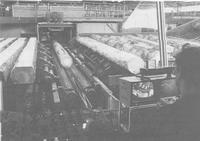


Chapter 4
I Management Of Native Forests
II Plantations-high Productivity Resources
III Protecting The Resource
IV Harvesting The Resource
V Solid Wood And Its Processing
i Sawmilling
ii Drying
iii Preservation
iv Quality and standards
VI Minor Forest Products
VII Reconstituted Wood Products
VIII Pulp And Paper
IX Export Woodchips
X Future Directions
XI Acknowledgements
References
Index
Search
Help
Contact us

Sawmilling (continued)
When a flitch is cut from a log with high growth stress it will tend to spring away from the log as it is being sawn and give rise to longitudinal bending, which leads to increased waste because of the need for subsequent 'face cutting' to straighten it. The nature of growth stress was first demonstrated at the Commonwealth Forestry Bureau in 1938 by Jacobs,[47] who showed it to be due to longitudinal tension in the outer parts of the trunk, balanced by a compressive force at its centre, and that the stress gradient from pith to bark was higher for younger and smaller diameter trees than for mature trees. Its presence is often first indicated by the radial cracks which may appear at the ends of logs on felling or soon thereafter.Jacobs claimed that growth stress occurred not only in the eucalypts but also in other woods, although its magnitude may be slight as, for example, in the conifers. The origin of the longitudinal tension forces developed in the outer wood and the accompanying lateral compressive force was explained by Boyd[48] in terms of the longitudinal contraction and lateral expansion known to occur in the maturing cells in the new wood being laid down at the periphery of the trunk.
Among the practices adopted to alleviate the conversion problems experienced with the younger and smaller diameter regrowth eucalypts were storage of logs before sawing, either in water or under sprays, the use of short length logs, back sawing rather than quarter sawing (i.e. sawing to produce boards with faces essentially tangential to the growth rings rather than at right angles to them), and the use of twin sawing techniques to release growth stress simultaneously on opposite sides of the log.
Another important contribution to the use of woods prone to growth stress is the line bar log carriage which employs a relatively short 'line bar', hydraulically loaded at each end, to press against the side of the log or flitch just ahead of the saw. This is used to control continuously the configuration of the log or flitch with respect to the saw so that accurately dimensioned product is obtained even if 'spring' is present. Developed initially for re-sawing in the late 1960s by A. E. Gibson Pty. Ltd. of Kendall, NSW, the concept was further improved and then introduced for primary sawing of small diameter eucalypts by two Victorian ash mills. Its use has since spread considerably.
Softwood sawmilling in Australia is almost as old as that using hardwoods. Huon pine, kauri and hoop pine were all milled commercially from the early days of settlement and the re-sawing of imported softwoods, mainly Douglas fir from the west coast of North America, has been a major activity for well over a century. The technology used in native softwood sawmilling, unlike that for the hardwoods, tended to follow overseas practice and bandsawing became common, often for the full conversion of the log. At the outbreak of the Second World War Queensland produced all its own softwood needs and also exported to some of the other States. After the war, however, native softwood sawmilling decreased in importance as many resources became depleted.
A small sawmill to use radiata pine from plantations was established by the SA Woods and Forests Department at Wirrabara in 1903 and produced timber for apple cases and general building use. Other small mills followed and in 1925 drying kilns were installed at Wirrabara, enabling a much needed quality improvement to be achieved. The first sawmilling operation of any size to use radiata pine began in 1931 at Mount Burr, when the Department commissioned a much larger mill based on a Swedish gang saw. This mill was also equipped for kiln drying and generated much of its own electricity requirements from wood-waste-fired boilers. Since that time there has been a steady development of radiata pine sawmilling in the area by both private industry and the Department, and with the increasing availability of large mature trees bandsawing was introduced.

Organisations in Australian Science at Work - A. E. Gibson Pty Ltd; Forestry and Timber Bureau; South Australia. Woods and Forests Dept
People in Bright Sparcs - Boyd, J. D.; Jacobs, M. R.
 |
Australian Academy of Technological Sciences and Engineering |  |
© 1988 Print Edition pages 216 - 218, Online Edition 2000
Published by Australian Science and Technology Heritage Centre, using the Web Academic Resource Publisher
http://www.austehc.unimelb.edu.au/tia/227.html